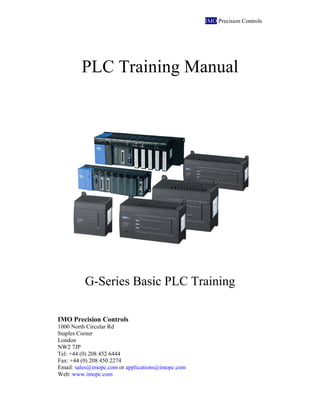The document is an instruction manual for IMO Precision Controls' G-Series PLC training. It provides an overview of IMO's G-Series PLC lineup, including the G7, G6, and G4 models. It also gives instructions on installing the GMWin programming software, provides an introduction to using GMWin, and covers topics like project structure, variable declaration, ladder logic programming, and downloading programs to PLCs.













![IMO Precision Controls
Page 8
Select the destination folder for GMWin to be installed into. If [Browse] is clicked
then a dialogue box will appear for the path to be inputted. Select the path to install to
or manually write the path in the box and click [OK].
After selecting the path to install, click [Next].
After confirming the path to install into, click [Next] to continue.](https://image.slidesharecdn.com/plctrainingmanual-230912042740-4b0d9966/85/plc_training_manual-pdf-14-320.jpg)





![IMO Precision Controls
Page 14
Clicking [Finish] will complete the set up process and return you to the main Window
with a fuller Project to begin programming.
The next stage is to
define the first
program. This can be
edited later and even
removed but initially
this must be set up.
The program will
initially be called
noname.src, but to
modify this, simply
highlight the area
shown and enter a
name that has more
meaning to your
application.
Next we have to select
what language we are
going to write the
program in. The
default is ladder.
SFC, LD and IL will
be discussed in more
detail later.
There is also an
opportunity to add
further documentation
notes.](https://image.slidesharecdn.com/plctrainingmanual-230912042740-4b0d9966/85/plc_training_manual-pdf-20-320.jpg)
































































































